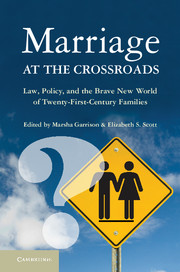Book contents
- Frontmatter
- Contents
- Contributors
- Acknowledgments
- Introduction
- Part I History, Demographics, and Economics – Multiple Perspectives on Families
- Part II Empirical Research on Family Change
- 6 Institutional, Companionate, and Individualistic Marriages
- 7 Marriage and Improved Well-Being
- 8 Fragile Families
- 9 Should Marriage Matter?
- Part III Family Policy and Law for the Twenty-First Century
- Comments
- Index
- References
9 - Should Marriage Matter?
Published online by Cambridge University Press: 05 November 2012
- Frontmatter
- Contents
- Contributors
- Acknowledgments
- Introduction
- Part I History, Demographics, and Economics – Multiple Perspectives on Families
- Part II Empirical Research on Family Change
- 6 Institutional, Companionate, and Individualistic Marriages
- 7 Marriage and Improved Well-Being
- 8 Fragile Families
- 9 Should Marriage Matter?
- Part III Family Policy and Law for the Twenty-First Century
- Comments
- Index
- References
Summary
INTRODUCTION
Since 1970, Americans’ median age at first marriage has increased by about five years for both men (23.2 to 28.2) and women (20.8 to 26.1) (U.S. Bureau of the Census 2010). The necessary consequence is a decline in the proportion of men and women who marry by any benchmark age. Whereas 94 percent of women born between 1940 and 1944 had married by age forty, only 86 percent of those born between 1960 and 1964 had (Ellwood & Jenks 2004). The question is whether this decline is an artifact of the increasing age at first marriage or a true decline in the proportion of the population that will ever marry. Researchers are divided on this puzzle (Blau, Ferber, & Winkler 1998:274; Oppenheimer 1994). The current consensus seems to be that the educated continue to marry at the same rate but later in life, while the less educated have experienced a true decline in the proportion who ever marry (Cherlin 2010:404; Goldstein & Kenney 2001).
There have been larger marriage-rate declines in some European countries where an increasing proportion of couples live in long-term, marriage-like relationships without formal marriage. But in the United States, cohabiting relationships remain largely short-term, usually ending with separation or marriage. Yet longer-term cohabiting relationships are perhaps becoming more common here also, even among couples with children. In any event, the possibility invites our consideration of how Americans believe the law should deal with such relationships. The potential legal questions divide between those that involve the couple's treatment by third parties, such as employers and government agencies, and those that involve the couple's rights with respect to one another (their rights inter se). Both categories are obviously important. This chapter focuses on the second.
- Type
- Chapter
- Information
- Marriage at the CrossroadsLaw, Policy, and the Brave New World of Twenty-First-Century Families, pp. 170 - 198Publisher: Cambridge University PressPrint publication year: 2012
References
- 2
- Cited by



